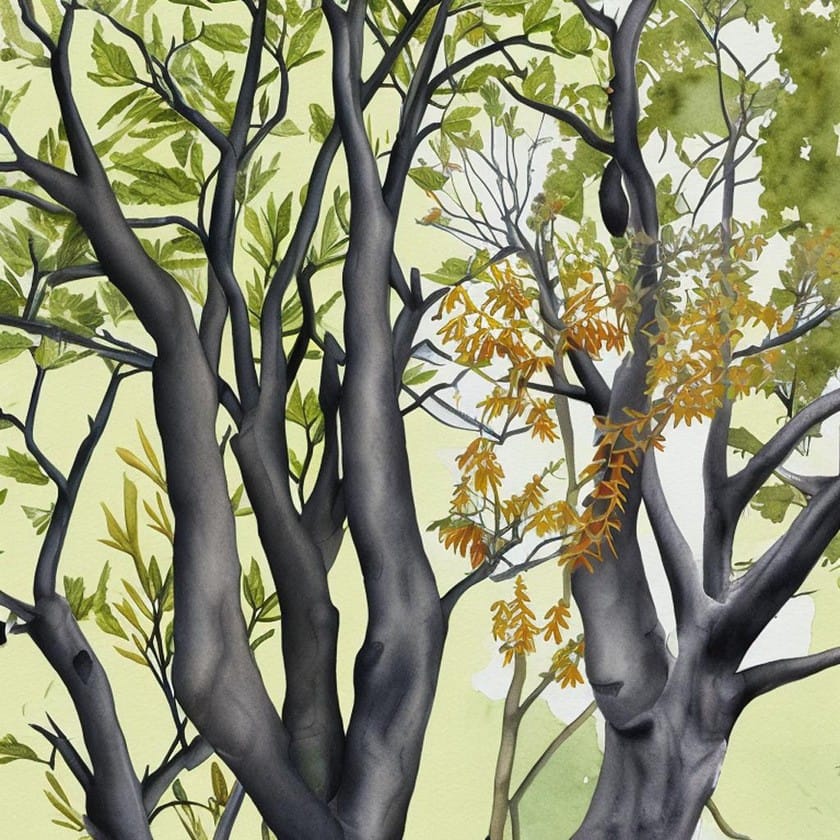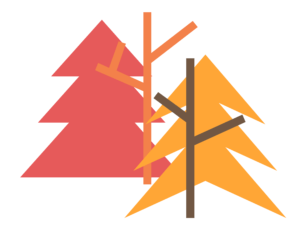Most endangered tree species in Australia
Australia is home to many unique and threatened tree species, here are some of the most endangered:
Nothofagus cunninghamii (Silver Beech)
Nothofagus cunninghamii, commonly known as Silver Beech, is a magnificent tree species native to the cool, temperate rainforests of southeastern Australia. These forests, characterized by their lush greenery and moist, temperate climate, provide an ideal habitat for the Silver Beech, which thrives in the rich, fertile soils of this region. The tree is easily recognizable by its smooth, grey bark and dense, spreading canopy, which offers shelter and sustenance to a diverse array of wildlife.
However, the Silver Beech faces significant threats that jeopardize its survival. Habitat loss and degradation, driven by logging, land clearing, and urban development, have significantly reduced the extent of these ancient forests. The fragmentation of habitats not only decreases the populations of Silver Beech trees but also disrupts the delicate ecosystems they support.
Climate change poses another critical threat to the Silver Beech. As temperatures rise and weather patterns become more unpredictable, the cool, moist conditions essential for the growth of these trees are increasingly at risk. Changes in rainfall patterns and the frequency of extreme weather events can lead to stress and decline in Silver Beech populations.
Additionally, the Silver Beech is vulnerable to disease, which can spread rapidly in fragmented and stressed ecosystems. Pathogens such as myrtle rust pose a particular threat, causing significant damage to leaves, stems, and even the death of infected trees.
Conservation efforts are crucial to protect the Silver Beech and its habitat. These efforts include the establishment and management of protected areas, the promotion of sustainable land-use practices, and ongoing research to understand and mitigate the impacts of climate change and disease. Public awareness and education are also vital to garner support for conservation initiatives.
Preserving Nothofagus cunninghamii is not only essential for maintaining biodiversity but also for protecting the ecological integrity and natural heritage of southeastern Australia. By safeguarding the Silver Beech, we contribute to the resilience of temperate rainforest ecosystems and ensure that future generations can continue to marvel at these ancient and majestic trees.
Eucalyptus regnans (Mountain Ash)
Eucalyptus regnans, commonly known as Mountain Ash, is a towering and awe-inspiring tree species native to the cool, temperate rainforests of southeastern Australia. Renowned for its incredible height, the Mountain Ash holds the title of the tallest flowering plant in the world, with some individuals reaching over 100 meters. These giants dominate the landscape, creating majestic, cathedral-like forests that are vital for the biodiversity and ecological health of the region.
However, the Mountain Ash faces significant threats that endanger its survival. Habitat loss and degradation, primarily driven by logging and land clearing for agriculture and urban development, have drastically reduced the extent of these ancient forests. The fragmentation of habitats not only diminishes the populations of Mountain Ash trees but also disrupts the complex ecosystems they support, affecting countless plant and animal species.
Climate change poses another critical threat to the Mountain Ash. The cool, moist conditions that are crucial for the growth of these trees are increasingly jeopardized by rising temperatures and altered rainfall patterns. Extreme weather events, such as droughts and bushfires, are becoming more frequent and severe, further stressing the Mountain Ash and its environment. These trees are particularly vulnerable to intense bushfires, which can decimate entire stands and hinder regeneration.
Additionally, the Mountain Ash is susceptible to disease, which can spread more easily in stressed and fragmented forests. Pathogens such as myrtle rust and other fungal infections can cause significant damage, impacting the health and survival of these iconic trees.
Conservation efforts are essential to protect the Mountain Ash and its habitat. Strategies include the establishment and management of protected areas, the promotion of sustainable forestry practices, and ongoing research to understand and mitigate the impacts of climate change and disease. Public awareness and education are also crucial to garner support for conservation initiatives.
Preserving Eucalyptus regnans is not only vital for maintaining biodiversity but also for safeguarding the ecological and cultural heritage of southeastern Australia. By protecting the Mountain Ash, we contribute to the resilience of temperate rainforest ecosystems and ensure that future generations can continue to witness and be inspired by these towering natural wonders.
Angophora costata (Sydney Red Gum)
Angophora costata, commonly known as Sydney Red Gum, is a distinctive and beautiful tree species native to the coastal regions of southeastern Australia. Known for its smooth, pinkish-red bark that peels away to reveal striking patches of orange and grey, the Sydney Red Gum is a prominent feature of the coastal woodlands and forests. Its gnarled branches and lush canopy provide essential habitat and food for a wide range of wildlife, including birds, mammals, and insects.
Despite its ecological importance and striking appearance, the Sydney Red Gum faces significant threats. Habitat loss and degradation, driven by urban expansion, agriculture, and infrastructure development, have led to a considerable reduction in the natural range of these trees. The clearing of land for housing and industry fragments the habitat, making it difficult for Sydney Red Gum populations to thrive and regenerate.
The spread of invasive species poses another serious threat to the Sydney Red Gum. Non-native plants and animals can outcompete native species for resources, introduce diseases, and alter the structure and function of ecosystems. Invasive plant species, in particular, can encroach upon the habitats of Sydney Red Gums, crowding them out and preventing young trees from establishing themselves.
Conservation efforts are crucial to protect Angophora costata and its natural habitat. These efforts should include the preservation and restoration of coastal woodlands, the control and management of invasive species, and the implementation of sustainable land-use practices. Public education and awareness campaigns can also play a vital role in promoting the importance of conserving this iconic tree species.
Protecting the Sydney Red Gum is essential not only for maintaining biodiversity but also for preserving the unique character and ecological health of southeastern Australia’s coastal regions. By safeguarding Angophora costata, we ensure the survival of a tree that has long been a symbol of resilience and natural beauty, enriching the landscape and supporting the diverse life forms that depend on it.
Acacia pycnantha (Golden Wattle)
Acacia pycnantha, commonly known as the Golden Wattle, is a vibrant and significant tree species native to southeastern Australia. Adorned with bright yellow, fragrant flowers, the Golden Wattle is not only Australia’s national floral emblem but also a crucial part of the local ecosystem. This species provides an important source of nectar for a variety of native wildlife, including bees, birds, and butterflies, playing a vital role in supporting pollination and maintaining biodiversity.
Despite its ecological and symbolic importance, the Golden Wattle faces several threats that endanger its survival. Habitat loss and degradation, primarily due to agricultural expansion, urban development, and infrastructure projects, have led to significant reductions in its natural habitat. These activities result in the fragmentation of landscapes, making it increasingly difficult for Golden Wattle populations to thrive and regenerate.
The spread of invasive species presents another serious challenge to the Golden Wattle. Non-native plants can outcompete native vegetation for resources such as light, water, and nutrients, leading to declines in Golden Wattle populations. Invasive animal species can also disrupt the delicate balance of local ecosystems, further threatening the health and stability of these habitats.
Conservation efforts are essential to protect Acacia pycnantha and its environment. Strategies to preserve this species should include habitat restoration projects, the control and management of invasive species, and the promotion of sustainable land-use practices. Public awareness and education campaigns can help highlight the importance of the Golden Wattle and encourage community involvement in conservation activities.
Protecting the Golden Wattle is crucial not only for maintaining biodiversity but also for preserving a symbol of Australia’s natural heritage. By safeguarding Acacia pycnantha, we support the ecosystems that depend on it and ensure that future generations can continue to enjoy the beauty and ecological benefits of this iconic species. The conservation of the Golden Wattle represents a commitment to the preservation of Australia’s unique flora and the rich biodiversity that defines its landscapes.
Allocasuarina littoralis (Black Sheoak)
Allocasuarina littoralis, commonly known as Black Sheoak, is a distinctive tree species native to the coastal regions of southwestern Australia. Recognized for its dark, furrowed bark and fine, needle-like foliage, the Black Sheoak is an important component of the coastal woodlands and heathlands. This species plays a vital ecological role, providing habitat and food for a variety of native wildlife, including birds and insects. The seeds of the Black Sheoak are particularly favored by the endangered Glossy Black-Cockatoo, making the tree crucial for the conservation of this and other species.
Despite its ecological importance, the Black Sheoak faces significant threats. Habitat loss and degradation, driven by urban development, agriculture, and infrastructure projects, have led to the fragmentation and reduction of its natural habitats. These activities disrupt the delicate balance of the ecosystems in which the Black Sheoak thrives, making it increasingly difficult for the species to regenerate and maintain healthy populations.
The spread of invasive species further compounds the challenges faced by the Black Sheoak. Invasive plants can outcompete native vegetation for essential resources such as light, water, and nutrients, leading to declines in Black Sheoak populations. Additionally, invasive animals can alter soil composition and structure, further hindering the growth and survival of native plants.
Conservation efforts are crucial to protect Allocasuarina littoralis and its natural environment. These efforts should include habitat restoration projects, the control and management of invasive species, and the implementation of sustainable land-use practices. Public education and awareness campaigns can also play a significant role in promoting the importance of conserving this unique tree species.
Protecting the Black Sheoak is essential not only for maintaining biodiversity but also for preserving the unique character and ecological health of southwestern Australia’s coastal regions. By safeguarding Allocasuarina littoralis, we contribute to the resilience of coastal ecosystems and support the diverse life forms that depend on these habitats. The conservation of the Black Sheoak underscores the broader commitment to protecting Australia’s natural heritage and ensuring the sustainability of its rich and diverse ecosystems.
These species and many others play important roles in maintaining biodiversity and providing vital ecosystem services in Australia, such as regulating water and air quality, supporting wildlife, and providing habitat for native species. Conservation efforts are needed to ensure their survival.
Shop tip
Nothofagus cunninghamii (Silver Beech) on Amazon
Eucalyptus regnans (Mountain Ash) on Amazon
Acacia pycnantha (Golden Wattle) on Amazon
Allocasuarina littoralis (Black Sheoak) on Amazon
Trees of Australia on Amazon

Thank you for likes, shares and comments! 🌳🌴🌲🌵
Source OpenAI’s chatGPT Language Models, Dalle, AI trot and Fleeky
images Picsart and MIB
Invest in your future
Take time to learn
Embark on your journey in affiliate marketing and website creation alongside an incredible community and myself. Invest in your future by dedicating time to learn and earn. Take all the time you need to master the basics before aiming higher. Give it a try and sign up for free. You won't regret it! Discover the possibilities for yourself...


